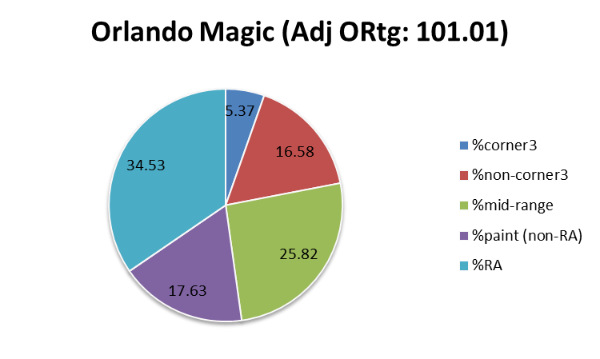How Much Does Shot Selection Affect NBA Team Offenses?

It’s difficult when evaluating offenses in basketball to figure why certain teams shoot the ball better than others. Is it the actual shooters, or is it the shot selection?
With players on shorter and shorter contracts, we get to see many players jump around to different teams and play in different offensive systems. It’s not very common for a player to suddenly become a good or bad shooter when they’ve been one way their entire career. Also, most offenses feature both good and bad shooters. Amazing two-way players are a rarity, so each offense will generally have a mixture of great offensive players who are average to bad defensively, and great defensive players who are average to bad offensively.
When you look at team data, shooting becomes less about shooters and more about shots. Sure, Dirk Nowitzki is a better shooter than anyone on the Pistons, but when you add in all of the shooters from both teams, shot selection becomes a much more important study.
So let’s look at just that –- shot selection. Thanks to NBAsavant.com, I’ve gathered shot selection data for the three teams that currently rank the best in offensive efficiency – the Dallas Mavericks, Toronto Raptors, and Los Angeles Clippers – and the three teams that currently are the worst in offensive efficiency – the Orlando Magic, Detroit Pistons, and Philadelphia 76ers.
The Good



As you can see, the good offenses have a healthy blend of shot selection. The best offense in the league – the Mavericks – shoots a large number of three-pointers, although their corner-three percentage isn’t as high as the Raptors or Clippers. What’s interesting is that the Mavericks haven’t necessarily limited mid-range shots. Their 24.1% mark is significantly higher than the Pistons (as you’ll see below), however they take a lot less shots in the non-restricted paint section than Detroit.
The disparity between the mid-range data can be explained by the type of mid-range shots the better offenses are taking. For example, the Mavs’ most frequent mid-range shooter, Nowitzki, is getting an average of 4.6 feet of distance from the closest defender on his shots. The Pistons’ most frequent shooter, Josh Smith, is only getting about 3.6 feet of distance from the closest defender on his shots. Mid-range shots won’t kill you; contested mid-range shots will.
The Raptors have quite the balanced chart, while the Clippers seemingly have been taking a lot of mid-range shots. However, their two pick-and-roll guards, Chris Paul and Jamal Crawford, are shooting a ridiculous .603 and .548 from the 16-feet to three-point range. That obviously isn’t sustainable – Paul is an average .453 shooter from that range, which is still very good – so we’ll see if the Clippers can keep up their offensive efficiency when regression in that area hits.
The Bad



The Magic have decidedly focused their roster on young players with defensive potential who can develop shooting. We all knew it would be ugly this year, and it has been so far. Only 5.37% of their shots have been the efficient corner-threes, and it’s not like they’re taking other three-pointers. It has been a lot of mid-range and in-the-paint contested shots that just haven’t fallen. Channing Frye was supposed to help with this, but has had a slow start after returning from injury.
The Pistons are an interesting case. Most analysts thought that new head coach Stan Van Gundy would turn them into his Magic teams of old, with Andre Drummond as his Dwight Howard. And while they are taking a lot of shots in the restricted area – even though their whopping 36.6% is still lower than the 76ers’ mark of 40.92% – they aren’t taking many three-pointers and defenses can pack the paint.
The 76ers are in a league of their own, with the only sub-100 adjusted offensive rating in the league. And it’s not just barely below that 100 mark –- it’s way below at 95.6. They are taking a ton of three-pointers so far at 24.69%, but barely any of them are the easiest kind –- the corner-three. Instead, they’re taking a bunch of shots in the restricted area, as mentioned above, and just not getting efficient looks. They’re young and don’t have any good shooters, so this is expected, but it’s still very bad.
So what did we learn? Mostly that good offensive teams take smart shots. They maximize their high efficient shots, while also creating a balance across their offense. They don’t necessarily shy away from less efficient shots – they just make them more efficient by taking them when they’re open. The three-pointer will always been more efficient than a long two, but in general, open shots are more important than physical location. The good teams get these much more frequently.
















